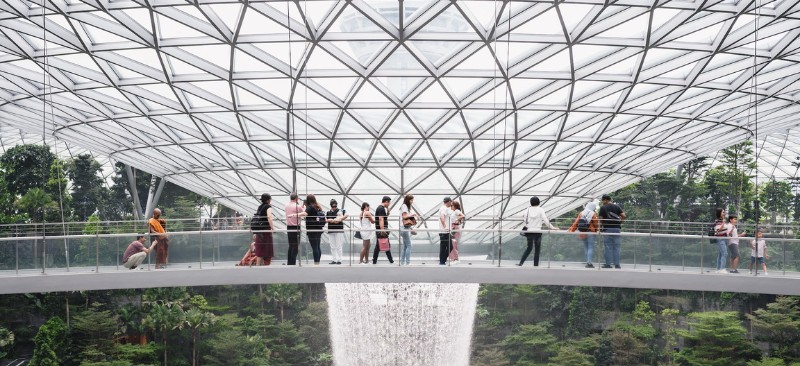Green transformation strategies: building sustainable tourism for the future

Image source: Nathaniel Yeo | Unsplash
“The pandemic and its impact on tourism, jobs, and revenues offer an unprecedented reminder of the need to rebalance our relationship with people, planet, and prosperity. The green transformation of the sector is needed, not just for the planet, but also for tourism itself, boosting competitiveness and increasing resilience.” – UNWTO Secretary-General Zurab Pololikashvili
While the world is seeking to adapt to the “new normal” set by an ongoing pandemic, the future of the tourism industry remains highly uncertain. According to the UNWTO World Tourism Barometer released in January 2022, global tourism registered an increase of 4% in 2021, with 15 million more international tourist arrivals compared to 2020. Still, these levels remain 72% below the pre-pandemic year 2019. Meanwhile, the latest UNWTO Panel of Experts survey reveals that most experts (64%) agree that international tourism will not reach the 2019 levels until 2024 or later.
Beyond the economic and social disruption, the pandemic crisis has disclosed existing structural weaknesses in the tourism sector, along with breaches in governmental and industry preparedness or response capabilities. Fragmented sectors and differences in the nature of tourism; seasonality; consumption of natural resources; impacts on climate change; and relative importance of tourism in the economy are only some of the shortcomings, as shown by the OECD Tourism Paper in 2021.
Moreover, recent studies indicate that the demand for tourism is undergoing significant behavioral changes towards more sustainable travel patterns that were amplified by the pandemic. For instance, a 2021 Eurobarometer survey showed that 82% of European citizens are inclined to include more sustainable practices in their travel habits, such as consuming locally sourced products, reducing waste and water consumption, traveling off-season or to less-visited destinations, and choosing transport alternatives based on their ecological impact. These results are supported by another survey conducted by Booking.com across 30 countries worldwide that gathered insights from 29,000 travelers. Seventy-three percent of the participants in the survey would be more likely to choose an accommodation if it has implemented sustainability practices.
Such studies prove that there is an increasing need for developing more sustainable and resilient models of tourism, supported by policymakers and service providers. In other words, a change of paradigm is needed, and green transformation policies and strategies seem to be the approach that will bring resilience and balance between “the needs of people, planet, and prosperity” in the tourism ecosystem.
The role of green transformation in sustainable industry recovery
Green transformation is not a new concept for the world economy, and it emerged as a trend in the tourism industry even before the pandemic. In a broad sense, the concept refers to “combining economic growth with caring about the environment to guarantee a high quality of life for present and future generations, at the level which is attainable due to civilizational development, as well as to an effective and rational use of the available resources” (Cheba et al., 2022, p.1).
In particular, green transformation involves an integrated approach that relies on combining legal regulations, innovative technologies, strategies, and clear initiatives to create sustainable and environmentally friendly markets. As the pandemic hastened the call for a green transformation in tourism, worldwide organizations and policymakers are planning strategies, key actions, and targets to achieve long-term competitiveness and sector recovery.
There is a general consensus that the industry must continue to build digital skills, implement digital solutions, create sustainable infrastructure, and address sustainable travel patterns. In early 2022, the European Commission’s Directorate-General for Internal Market, Industry, Entrepreneurship and SMEs released the Transition Pathway for Tourism, a report that introduces a set of strategy recommendations for the tourism ecosystem, based on the objectives of the European Green Deal. Within this report, the European Commission refers to the “tourism ecosystem” as businesses that work in sectors such as food and beverage services, on-line information and services providers (tourist offices, digital platforms, travel technology providers), travel agents and tour operators, accommodation suppliers, destination management, attractions and passenger transport (pg. 2).
Some of the key strategies and their related targets are as follows:
- Passenger transport companies (aviation, water, and land transport) should reduce Greenhouse Gasses (GHG) to become climate neutral by 2050.
- European cities and regions should develop sustainable mobility for climate-neutral cities, by implementing mobility plans and by doubling the high-speed rail traffic by 2030.
- Buildings have to become more energy and resource-efficient, and energy support must move towards sustainable renewables.
- Hospitality and all tourism services should implement circular models and diminish their environmental footprint. This includes reducing by half the amount of non-recycled waste by 2030 and lower food waste, single-use plastics, air pollutants, and water pollution while increasing water efficiency.
- Each destination or tourism service provider should build their communication strategy on transparency towards sustainability and environmental footprint, thus guiding and empowering consumers’ choices.
Furthermore, the World Tourism Organization considers that “transforming tourism operations for climate action continues to be of utmost importance for the sector to remain in line with the international goals.” To support that, three main goals and actionable ways for their achievement were introduced in the Recommendations for the transition to a green travel and tourism economy: monitor and report CO2 emissions from tourism operations; accelerate the decarbonization of tourism operations; and engage the tourism sector in carbon removal.
Green transformation strategies in practice
Around the world, different practices of strategy planning and ongoing actions stand as evidence for the shift to a green travel and tourism economy as a roadmap for sustainable and resilient growth.
In the recovery from COVID-19, Kyoto (Japan), “a city where history and culture give rise to hope,” reconfigured its urban development and tourism strategy in 2021. The recovery strategy aims to develop the city as a higher-quality destination for both residents and tourists while supporting the Sustainable Development Goals (SDGs) recommended by the United Nations.
As stated in the Kyoto Tourism Promotion Plan 2025, five Goals for Urban Development and Tourism are to be achieved by 2030:
- Harmony between the life of residents and tourism, allowing the local populace to feel enriched
- All actors are involved in refining the “light of Kyoto” and improving tourism quality.
- Tourism industry leaders become more active, and entrepreneurship of new businesses in the fields of tourism and culture flourish, contributing to improve the vitality of the city and cultural inheritance
- Ensuring flexible, strong, safe, secure and environmentally sustainable tourism that can cope with various crises, such as infectious diseases and disasters
- Establishing the city’s credentials as an attractive MICE city, welcoming people from all over the world, recognizing diversity, and contributing to world peace
Measuring the progress towards achieving their vision is ensured by key performance indicators set for each of the five goals, which are meant to be evaluated on a regular basis. Several examples of KPIs included in the strategy plan are as follows:
- % Full-time employment in the tourism sector
- % Satisfaction level of tourism workers
- % Tourism businesses whose products and unit prices have increased
- % Tourism businesses contributing to the local community
- % Tourism businesses that take into consideration the environment
- # International conferences held
One distinctive feature of the Kyoto strategy is the Code of Conduct for Sustainable Tourism in Kyoto (Kyoto Tourism Morals), which aims to provide “guidelines for the tourism industry and its workers, tourists, and residents to work together in united efforts to maintain harmony in Kyoto, and to preserve Kyoto for future generations.”
“Rebuilding tourism is also an opportunity for transformation with a focus on leveraging its impact on destinations visited and building more resilient communities and businesses through innovation, digitalization, sustainability, and partnerships.” – 2020 Tourism Policy Brief, United Nations
This article originally appeared in the 23rd PERFORMANCE Magazine – Printed Edition. Download your free copy from TKI Marketplace or get one in print via Amazon.

Tags: green transformation, Strategy planning, sustainable tourism, tourism





